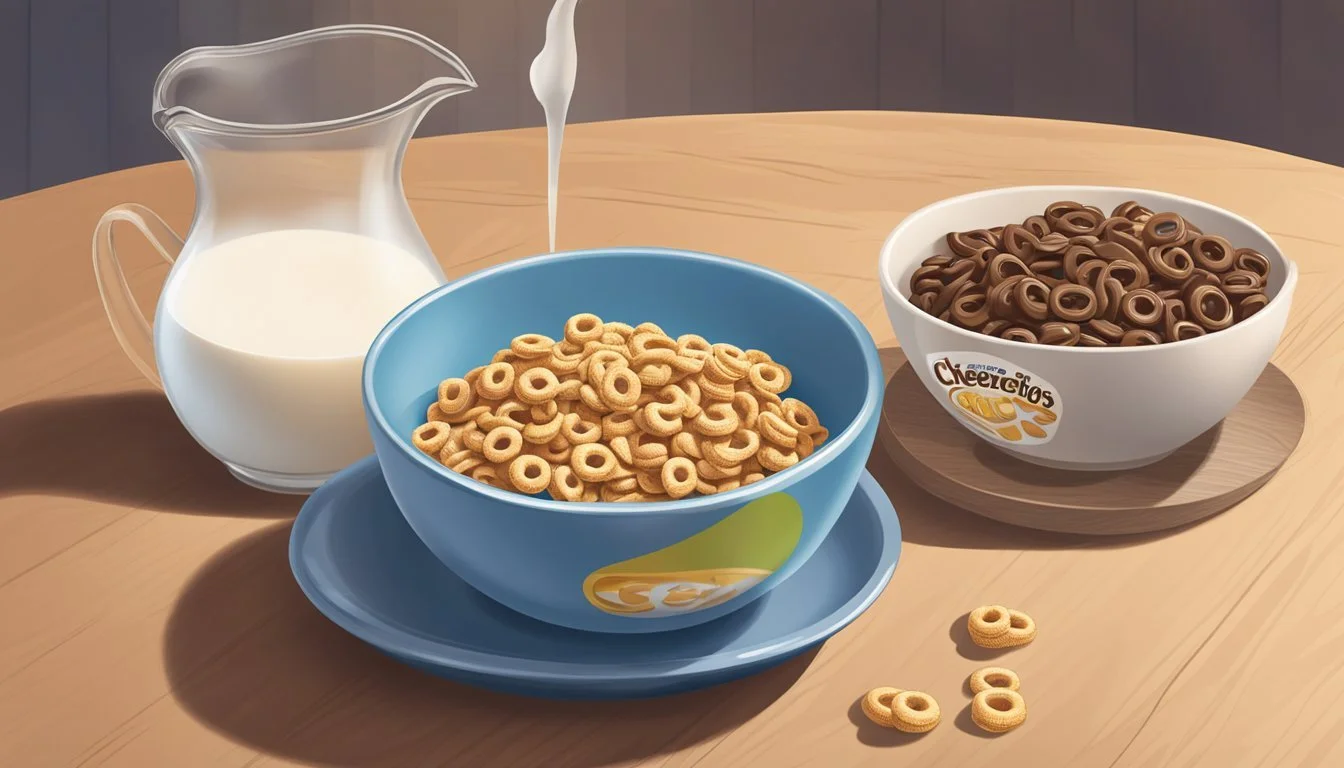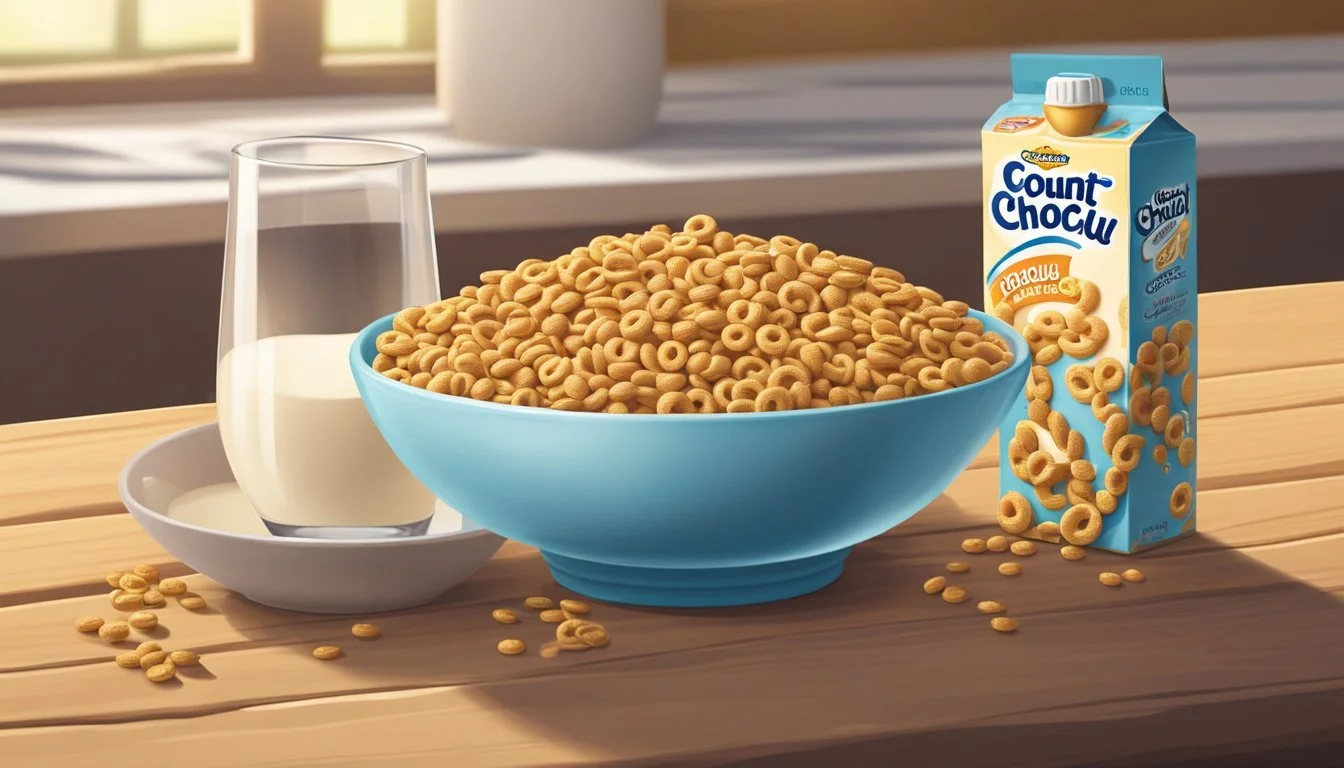Cheerios vs Count Chocula
Comparing Nutritional Value and Flavor
This Article is Part of Our Breakfast Cereal Guide with Details on Cheerios Nutrition and Count Chocula Nutrition
When it comes to choosing a healthy cereal option, many find themselves torn between Cheerios and Count Chocula. Both cereals, produced by General Mills, offer unique nutritional profiles that cater to different dietary needs. Cheerios, known for its high iron content, covers 206% more of the daily iron requirement than Count Chocula. This makes it an attractive option for those looking to boost their iron intake.
Count Chocula, on the other hand, provides significantly more Vitamin B2, containing 1.6mg compared to Cheerios' 0.1mg. This added vitamin B2 can be beneficial for those needing to support their energy metabolism. Yet, Cheerios also offers more grams of complex carbohydrates per serving, which can be essential for sustained energy release throughout the day.
Ultimately, the choice between Cheerios and Count Chocula depends on individual nutritional needs and taste preferences. For those seeking higher iron and sustained energy, Cheerios might be the better option. However, if the goal includes a boost in Vitamin B2 alongside a sweet start to the day, Count Chocula could be more suitable.
Historical Background
General Mills introduced Cheerios, one of the most iconic cereals, in 1941. Originally called CheeriOats, the name was changed in 1945. Cheerios became a staple breakfast option renowned for its simplicity and whole grain oats.
In contrast, Count Chocula was brought to market by General Mills in March 1971. This chocolate-flavored cereal featured a spooky mascot inspired by classic movie monsters.
Count Chocula was accompanied by Franken Berry, both becoming instant hits due to their unique taste and marshmallow bits. These cereals catered more to children's visual and taste preferences.
Cheerios' popularity grew due to its health benefits, particularly being low in sugar and rich in fiber. It was marketed as a nutritious choice for both children and adults.
General Mills has continuously innovated with Count Chocula, making it a seasonal favorite, especially around Halloween.
Cereal Introduction Year Flavor Mascot Cheerios 1941 Whole Grain Oats Cheerios Kid Count Chocula 1971 Chocolate Count Chocula
Both cereals underscore General Mills' impact on the breakfast cereal market, appealing to different demographics and preferences.
Nutritional Profiles
When comparing Cheerios and Count Chocula, examining their nutritional profiles provides a clear picture of their dietary impacts. This section breaks down the nutritional content, specific vitamins and minerals, and caloric values of each cereal.
Overall Nutritional Information
Cheerios and Count Chocula differ significantly in their nutritional composition. Cheerios contains 290 milligrams of sodium per serving, while Count Chocula has 180 milligrams of sodium per serving.
Cheerios offers 2 grams of dietary fiber per serving. In contrast, Count Chocula contains less fiber. Both cereals have roughly the same calorie count at around 110 calories per serving, with slight variations in other nutrients such as protein and fat.
Vitamins and Minerals Content
When it comes to vitamins and minerals, Cheerios and Count Chocula exhibit distinct variations. Cheerios provides 206% more iron than Count Chocula. Iron is crucial for oxygen transport in the blood, making Cheerios a better source for those needing higher iron intake.
Count Chocula, however, shines in Vitamin B2 content, offering 1.6 mg per serving compared to Cheerios' 0.1 mg. This vitamin is vital for energy production and skin health. Both cereals also contain other essential vitamins such as Vitamin D and various B vitamins but in differing quantities.
Caloric Comparison
The caloric content of both cereals is identical, with each containing approximately 110 calories per serving. This uniformity in caloric value allows for a more straightforward comparison of other nutritional aspects.
Cheerios provides 2 grams of protein per serving, surpassing Count Chocula's 1 gram per serving. The fat content also varies, with Cheerios having around 2 grams while Count Chocula contains only 1 gram. These differences highlight Cheerios' slightly higher nutrient density despite the same caloric intake.
Ingredient Analysis
Cheerios and Count Chocula differ significantly in their ingredients, with a focus on whole grains and dietary fibers in Cheerios and higher sugar content in Count Chocula. This section will break down the main ingredients, sugar and sweeteners, and the presence of allergens and preservatives.
Main Ingredients
Cheerios:
Whole Grain Oats: The primary ingredient, providing dietary fiber and essential minerals.
Corn Starch: Used as a thickening agent.
Sugar: Present in smaller amounts compared to Count Chocula.
Salt: Added for flavor.
Count Chocula:
Whole Grain Corn: Provides a different texture and fiber content than oats.
Corn Meal: Adds to the grain content.
Sugar and Corn Syrup: Major ingredients contributing to its sweet taste.
Cocoa: Provides chocolate flavor.
Cheerios emphasizes whole grains and has a simpler ingredient list, favoring fewer processed components than Count Chocula.
Sugar and Sweeteners
Cheerios contains limited sugars, mainly from added sugar and corn syrup, accounting for its lower sweetness. It offers a healthier option for those cutting down on sugar. Each serving contains minimal grams of added sugar, benefiting those monitoring blood sugar levels.
Count Chocula is much sweeter, containing a higher proportion of added sugars, including corn syrup, sugar, and fructose. This results in numerous grams of sugar per serving which contributes significantly to daily sugar intake. It's a more indulgent option and less suitable for those seeking a low-sugar diet.
Presence of Allergens and Preservatives
Cheerios:
Allergens: Primarily gluten from the oats, though there are gluten-free versions available.
Preservatives: Minimal, focusing on natural ingredients.
Count Chocula:
Allergens: May contain gluten, dairy, and soy, common allergens in processed cereals.
Preservatives: Includes BHT (Butylated Hydroxytoluene) to maintain freshness, and artificial dyes to enhance color.
Cheerios is more allergen-friendly with fewer preservatives, making it a safer choice for individuals with food sensitivities or those avoiding artificial additives.
Health Impact
Cheerios and Count Chocula have distinct differences in their nutritional profiles, impacting their suitability for various diets and health needs. Below, the aspects of dietary considerations and nutritional benefits are explored to provide a clearer picture.
Dietary Considerations
Cheerios offers a balanced profile suitable for individuals on a low-fat diet. They contain minimal amounts of fats and are low in sugars. Each serving contains 17 grams of complex carbohydrates, making them ideal for those on a low glycemic index diet due to their slower absorption rate.
Count Chocula, on the other hand, is higher in sugars with 13 grams per serving and contains 12 grams of complex carbohydrates. This makes it less suitable for low-carb or low-sugar diets. Additionally, Count Chocula contains higher amounts of sodium, which may affect those on low-sodium diets or with hypertension concerns.
Nutritional Benefits
Cheerios is rich in iron, covering 206% of the daily need, which is beneficial for preventing iron-deficiency anemia. It also provides a good amount of fiber, aiding in digestion and contributing to a feeling of fullness. Vitamins like B6 and B12 are present, supporting overall metabolic and nerve functions.
Count Chocula excels in its Vitamin B2 content, offering 1.6mg compared to Cheerios' 0.1mg. This vitamin is crucial for energy production. However, Count Chocula contains fewer beneficial nutrients such as fiber and protein, which might be less advantageous for those seeking a more nutritionally balanced cereal.
A comparison chart can be helpful:
Nutrient Cheerios Count Chocula Sugars 6g 13g Complex Carbs 17g 12g Iron 206% daily need Lower Vitamin B2 0.1mg 1.6mg Fiber High Lower
This detailed examination assists readers in making informed choices based on their specific dietary and nutritional requirements.
Comparative Analysis
Cheerios and Count Chocula offer distinct nutritional profiles and flavor experiences, making them appealing to different consumer segments. Examining their ratings, market trends, and flavors provides a comprehensive view of their positions in the cereal market.
Cereal Ratings and Consumer Preferences
Cheerios are often favored for their heart-healthy benefits, featuring low sugar content and moderate complex carbohydrates. Consumer ratings highlight Cheerios' simplicity and versatility as a top choice for families.
Count Chocula, by contrast, appeals to those preferring a sweeter, chocolate-flavored breakfast. It provides a significant amount of Vitamin B2 and iron, with higher sugar content than Cheerios. Consumer ratings for Count Chocula often mention its nostalgic value and unique taste.
Market Trends and Popularity
Cheerios maintain high popularity due to their reputation as a healthy cereal. They consistently rank well among cereals designed for adults concerned with nutritional value. Cheerios also offer variations such as Honey Nut Cheerios, which cater to different taste preferences while retaining the brand's healthful image.
Count Chocula's popularity peaks around Halloween, leveraging its themed character and festive appeal. The market trends for Count Chocula show it as a seasonal favorite more than a daily staple. This cereal finds its niche among those seeking a fun, indulgent breakfast choice.
Flavor Profiles and Varieties
Cheerios provide a mild, slightly toasted oat flavor making them versatile for various uses, including as snacks or in recipes. Flavors such as Honey Nut Cheerios and Apple Cinnamon Cheerios add a touch of sweetness while keeping the original's health benefits.
Count Chocula stands out with its rich chocolate flavor, complemented by marshmallow pieces that add texture and more sweetness. While its primary flavor remains consistent, it competes with similar cereals like Cocoa Puffs and Cinnamon Toast Crunch in the sugary cereal segment.
Cheerios and Count Chocula cater to different audience needs, shopper motivations, and dietary preferences, creating distinct market positions and consumer bases.
Serving Suggestions and Pairings
Determining the best ways to enjoy Cheerios and Count Chocula can enhance your eating experience. Pay attention to serving sizes, nutritional content, and the types of milk or alternatives you pair them with for a balanced meal.
Serving Sizes and Recommendations
Cheerios and Count Chocula differ significantly in their nutritional profiles. For a standard serving, Cheerios suggests about one cup (28 grams), whereas Count Chocula's serving size is the same. Cheerios offers 2 grams of dietary fiber and 1 gram of sugar per serving, making it an excellent choice for those focusing on fiber and low sugar intake.
Count Chocula, contrastingly, contains 0 grams of dietary fiber and 13 grams of sugar per serving. Despite its higher sugar content, Count Chocula can still fit into a balanced diet if paired with other nutrient-rich foods.
Recommended Serving Sizes:
Cheerios: 1 cup (28 grams)
Count Chocula: 1 cup (28 grams)
Milk and Alternatives
Pairing your cereal with the right milk or milk alternatives can impact its nutritional value.
Cheerios pairs well with traditional milk, providing a boost in calcium and protein. For those allergic or intolerant to lactose, almond milk or soy milk are excellent alternatives, offering additional nutrients like vitamins D and E. Almond milk's creaminess complements the texture of Cheerios, while soy milk's protein content enhances the meal's nutritional profile.
Count Chocula pairs best with whole milk if aiming to indulge, but for a healthier option, low-fat milk or oat milk makes a good choice. Low-fat milk reduces overall calorie intake while maintaining nutritional benefits. Oat milk, rich in fiber, compensates for Count Chocula's lack of dietary fiber.
Milk and Alternatives:
Cheerios: Whole milk, almond milk, soy milk
Count Chocula: Whole milk, low-fat milk, oat milk





